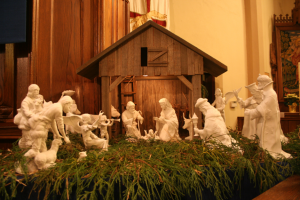O Come, All Ye Faithful: A Christmas Carol Reflection
 By Rob Durocher
By Rob Durocher
Minister of Music and the Arts, Deacon
I don’t know about you, but there is always something so incredibly triumphant and soul stirring when we all join together to sing the wonderful Christmas carol, O Come, All Ye Faithful at the beginning of each Christmas Eve service of worship! As far back as I can remember, and that’s a good long time, this has always been a carol that fills my musical senses and seals the deal for me that Christ became like us, fully human and that he became is the ‘Word of the Father now in flesh appearing’ and that we are extended a wonderful invitation to ‘come let us adore him, Christ the Lord!’
We sometimes use the word Christmas carol instead of the word Christmas hymn because while hymns are traditional poems based on scripture or scriptural thought and have been around for centuries sung by congregations in worship, carols, are seasonal, festive songs. They are usually religious in nature and represent Christmas, Easter and Advent, and have a joyful and festive character to them. O Come, All Ye Faithful in a way is actually BOTH a hymn and a Christmas carol!
The text of O Come, All Ye Faithful is a little bit of a mystery. There are some that say the text goes as far back as the 13th century but when it first appeared in publication, it was called Adeste Fidelis, laeti triumphates! The version that we are familiar with today is attributed to the 18th century hymnist, John Francis Wade. Wade (1711-1786) was a Catholic layman who left England to live in France following the Jacobean rebellion of 1745 (when the Catholic, exiled Stuart, ‘Bonnie Prince Charlie,’ grandson of former King James II who fled England at the glorious Revolution of 1688, tried to gain his ancestral throne of Scotland back from Protestant King George II of England. This was a time when England and Scotland were steadfastly Protestant and Catholics would often escape difficulties by fleeing to Europe for safety.) The text to Wade’s carol was written in Latin because Latin was considered the language of academia in the 18th century.
O Come, All Ye Faithful! was translated into English by in 1841 by Frederick Oakely, a former Anglican priest who converted to Roman Catholicism, and became a canon at Westminster and hymnals. Song books quickly adopted this newly translated Christmas carol. Oakley used four verses of the carol and 19th century hymnist William Brooke (1848 – 1917) added more some years later. The carol has evolved over subsequent years with stanzas falling away as other stanzas were added.
The tune ADESTE FIDELIS has been attributed to both Francis Wade and even to Frederick Oakely, with the refrain, O come, let us adore him being added later. Other possible composers have also been suggested like Thomas Arne, and John Reading. Another school of thought has this carol in a slightly different form attributed to King John IV of Portugal a musician, king, composer, and lover of the arts who might have written the tune. Throwing a little more confusion upon the carol’s history is the fact that Adeste Fidelis was also called the “Portuguese Hymn” since it was sung with great familiarity regularly in the Chapel of the Portuguese Embassy in London. Whatever its origination the carol has transcended borders and continues to be one of the best loved hymns and Christmas carols throughout the world.
In the first verse of the carol one hears the whisper of Luke 2:15 where the shepherds say “Let us go even unto Bethlehem and see this thing which is come to pass” which places us among the shepherds as they ran with joy to Bethlehem to see the newborn Holy child. We also join the great procession of the faith as they once journeyed in their hearts to Bethlehem!
The original second verse echoes John 1:14 and references the second article of Nicean Creed establishing a link that reaches back to the church of 325 A.D. to the Council of Nicea where the Creed originates. This verse is also filled with very good theology!
God of God, Light of Light, lo, he abhors not the Virgin’s womb.
Very God Begotten, not created. O come, let us adore Him, Christ the Lord!
In verse three we join with the angel’s chorus singing ‘Glory to God, glory in the highest’ (Luke 2:14),
Sing choirs of angels, sing in exultation; sing ye bright citizens of heaven above.
“Glory to God, all glory in the highest”!
The final verse triumphantly joins all those in heaven above and earth below in greeting and adoring our Lord and Savior, Jesus Christ at his incarnation as we sing:
Yea Lord we greet thee, born this happy morning; Jesus to thee be glory given!
WORD of the Father, now in flesh appearing. O come, let us adore him, Christ the Lord.
In these days of pandemic, political dissatisfaction and issues of racial inequity, this simple Christmas carol, O Come, All Ye Faithful still speaks to us! Throughout these last nine months we’ve been encouraged to ‘be bold and courageous,’ but to also be faithful! Being bold means being faithful. Jesus came into a world that was upside down. He entered ‘the midst of humanity that could have shocked his perfect nature.’ It wasn’t the rich and ennobled who went with haste to Bethlehem to ‘see this thing which has come to pass’, it was common shepherds and village folk. This was Jesus who would break bread with his friends and disciples, teach and preach from a mountainside, heal the sick, raise the dead, be misunderstood by his family, friends and the government of his day but would show us by his death and glorious resurrection that he was real and dynamic and that the power of his Gospel changes our lives giving us a newness that compels us to share this good news of salvation with others.
We are extended an invitation to ‘come and behold him, born the king of angels,’ an invitation for us to come to Jesus and find hope, forgiveness and life in him – this little child in a manger who now reigns supreme as King of kings and Lord of lords who reigns forever and ever. O COME, LET US ADORE HIM, CHRIST THE LORD!
Related Posts

Holy Land Pilgrimage



